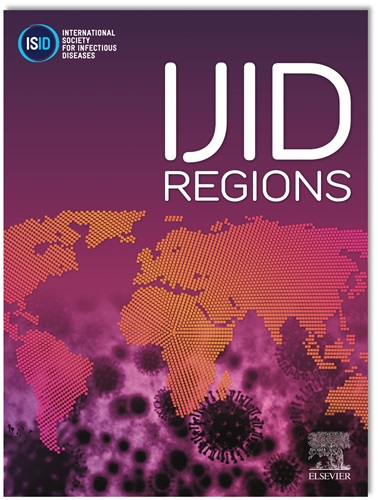COVID-19 vaccination and cerebral small vessel disease progression—A prospective cohort study
IF 4.8
2区 医学
Q1 INFECTIOUS DISEASES
引用次数: 0
Abstract
Objectives
The association between SARS-CoV-2 spike protein and cerebrovascular diseases raised a concern of cerebrovascular safety of COVID-19 vaccines. We aimed to determine the risk of radiologic cerebral small vessel disease (cSVD) progression with BNT162b2 and CoronaVac.
Methods
In this community-based prospective cohort study, community-dwelling subjects underwent brain magnetic resonance imaging (MRI) before and 4 months after vaccination with BNT162b2 or CoronaVac. Unvaccinated subjects received serial brain MRI over a comparable interval. The primary outcome was progression of a composite of six standard cSVD biomarkers. We compared the risk of cSVD progression between vaccinated and unvaccinated subjects and identified predictors of primary outcome within each vaccine subgroup.
Results
Of the 415 subjects recruited, 190 received BNT162b2, 152 received CoronaVac, and 73 remained unvaccinated. A total of 60 (14.4%) had COVID-19 infection before follow-up MRI, and 109 (26.3%) developed the primary outcome. Neither BNT162b2 (adjusted odds ratio [aOR] 0.61, 95% confidence interval [CI] 0.30-1.26, P = 0.179) nor CoronaVac (aOR 0.71, 95% CI 0.34-1.47, P = 0.349) was associated with cSVD progression. Among the BNT162b2 recipients, a higher surrogate virus neutralization test was associated (aOR 0.97, 95% CI 0.95-0.99, P = 0.002) with a lower risk of cSVD progression.
Conclusions
BNT162b2 and CoronaVac did not increase cSVD burden in community-dwelling citizens. The association between surrogate virus neutralization test and cSVD progression among BNT162b2 recipients requires further investigation.

COVID-19疫苗接种与脑血管疾病进展——一项前瞻性队列研究
背景:SARS-CoV-2刺突蛋白与脑血管疾病的相关性引起了对COVID-19疫苗脑血管安全性的关注。我们的目的是确定BNT162b2和CoronaVac的放射性脑血管病(cSVD)进展的风险。方法:在这项以社区为基础的前瞻性队列研究中,居住在社区的受试者在接种BNT162b2或CoronaVac前和接种后4个月接受了脑MRI检查。未接种疫苗的受试者在相同的时间间隔内接受了连续的脑部MRI检查。主要终点是六种标准cSVD生物标志物的复合进展。我们比较了接种疫苗和未接种疫苗的受试者之间cSVD进展的风险,并确定了每个疫苗亚组内主要结局的预测因素。结果:在招募的415名受试者中,190名接种了BNT162b2, 152名接种了CoronaVac, 73名未接种疫苗。60例(14.4%)在随访MRI前已感染COVID-19, 109例(26.3%)出现主要结局。BNT162b2 (aOR 0.61, 95%CI 0.30-1.26, p=0.179)和CoronaVac (aOR 0.71, 95%CI 0.34-1.47, p=0.349)与cSVD进展均无相关性。在BNT162b2受体中,较高的替代病毒中和试验(sVNT)与较低的cSVD进展风险相关(aOR 0.97, 95%CI 0.95-0.99, p=0.002)。结论:BNT162b2和CoronaVac不会增加社区居民的心血管疾病负担。BNT162b2受体中sVNT与cSVD进展之间的关系有待进一步研究。
本文章由计算机程序翻译,如有差异,请以英文原文为准。
求助全文
约1分钟内获得全文
求助全文
来源期刊
CiteScore
18.90
自引率
2.40%
发文量
1020
审稿时长
30 days
期刊介绍:
International Journal of Infectious Diseases (IJID)
Publisher: International Society for Infectious Diseases
Publication Frequency: Monthly
Type: Peer-reviewed, Open Access
Scope:
Publishes original clinical and laboratory-based research.
Reports clinical trials, reviews, and some case reports.
Focuses on epidemiology, clinical diagnosis, treatment, and control of infectious diseases.
Emphasizes diseases common in under-resourced countries.

 求助内容:
求助内容: 应助结果提醒方式:
应助结果提醒方式:


